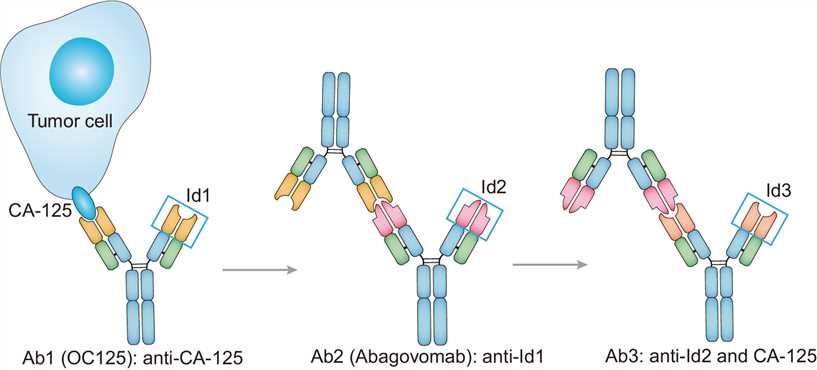

Abagovomab Overview
Introduction of Abagovomab
Abagovomab is a murine monoclonal anti-idiotypic antibody (MW: 165-175 kDa), produced by a mouse hybridoma and generated against OC125, which serves to functionally imitate the human cancer antigen 125 (CA-125). Abagovomab has been developed by the pharmaceutical company Menarini for the treatment of ovarian cancer. It (ab2) shows high affinity for the paratope of ab1, and binding of ab2 to Ab1 is almost completely inhibited (93%) by the nominal antigen. The administration of F(ab')2 fragments of abagovomab to rats produces anti-CA-125 immunity with the production of IgG and IgM anti-anti-idiotypic antibodies (ab3) that bind both to abagovomab and CA-125. Non-MHC restricted cell-mediated cytotoxicity for NIH OVCAR3 cell lines is also demonstrated.
Abagovomab has been evaluated in three clinical studies, beginning with a Phase Ib/II study to primarily demonstrate the safety of abagovomab and its ability to stimulate a specific immunologic response. This was followed by two Phase I trials that evaluated the effect of different doses, routes of administration and durations of treatment on the safety and immune responses prior to selecting the optimal dosage and schedule for the pivotal Phase III trial. The Phase Ib/II study showed a strong association with the production of Ab3 and overall survival. The results of the first three studies have been reported, while the pivotal Phase III trial Monoclonal antibody Immunotherapy for Malignancies of Ovary by Subcutaneous Abagovomab (MIMOSA) has completed accrual and efficacy results are expected by the second quarter of 2011.
Mechanism of Action of Abagovomab
The variable regions of an antibody (Ab1) contain a structure which is recognizable by the variable region of another antibody, and such determinant is called an idiotope that is immunogenic and able to induce antibodies. A collection of idiotopes is called an idiotype of an antibody, and the antibody (Ab1) induced by a specific antigen induces anti-idiotypic antibodies (Ab2) which in turn induces anti-anti-idiotypic antibodies (Ab3). Within this network, a subset of the anti-idiotypic antibodies (Ab2) has a structure closely resembling the epitope of the original antigen and induces an antibody-response similar to that induced by the original antigen; likewise, a proportion of the anti-anti-idiotypic antibodies (Ab3) has the same structure (epitope) as Ab1. Abagovomab is a murine-monoclonal antibody generated by the immunization of mice with the OC125 antibody against CA-125. Abagovomab (anti-idiotypic antibodies Ab2) administration could induce the production of Ab3 antibodies in patients, with a proportion of them having the same structure (epitope) of Ab1 antibodies directed against the original CA-125 antigen. CA-125 is one of the known tumor-associated antigens (TAA) for ovarian cancer and is highly expressed on epithelial cancer cells. CA-125 is detected with a high frequency in sera of more than 80% of patients with epithelial ovarian cancer, and the sero-prevalence and serum titers of this TAA become elevated with cancer progression. CA-125 is a validated tumor marker used to evaluate therapeutic response as well as to predict disease recurrence. In pre-clinical studies, the induction of a non-MHC-restricted cell-mediated lysis of CA125-expressing tumor cells has been demonstrated, as well as complement-dependent cytotoxicity (CDC) and antibody dependent cellular cytotoxicity (ADCC).

Fig 1. Mechanism of Action of Abagovomab
What We Provide
Therapeutic Antibody
Abagovomab
We provide high-quality Abagovomab for use in WB, FC, IP, ELISA, Neut, FuncS, IF and most other immunological methods. For lab research use only, not for diagnostic, therapeutic or any in vivo human use.
For research use only. Not intended for any clinical use.
This site is protected by reCAPTCHA and the Google Privacy Policy and Terms of Service apply.

